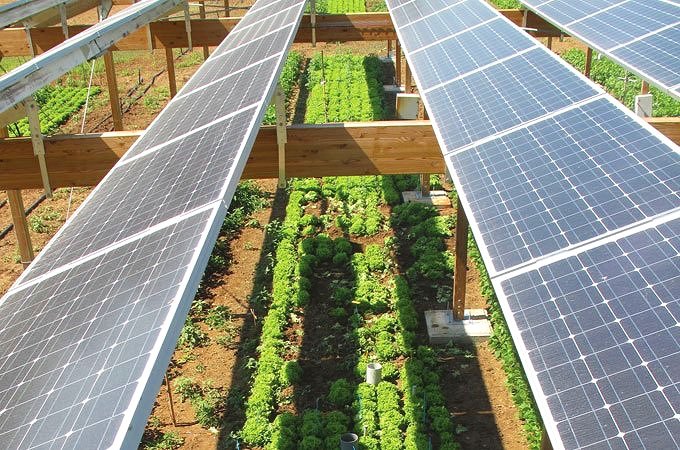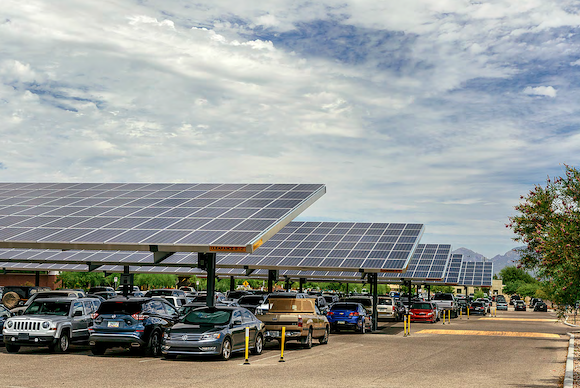Dual-Axis Solar Trackers: More Energy per Square Foot
What is a solar tracker?
Solar trackers are solar solutions that move with the sun throughout the day. They consist of a metal support frame that the panels are mounted on, metals poles or structure that hold the frame and a moving mechanism that tilts or rotates the frame. The development of solar trackers was inspired by the idea that keeping the solar panels in or close to the optimal position of facing the sun would result in increased solar energy collection.
Types of solar trackers
There are two main types of solar trackers: single-axis and dual-axis trackers. While single-axis tracking systems can only track the sun's east to west movement during the day with a simple tilt, dual-axis trackers move along two axes and follow the exact position of the sun throughout the day and the year.
Single-axis trackers
Singe-axis trackers are installed on long parallel rows of racking structure with panels tilting up and down. With sophisticated control software that can distinguish between sunny, windy, and overcast weather, single axis solar trackers can produce 30 to 40 percent more energy than fixed ground-mount PV solutions.
However, single-axis trackers are only cost-effective for large, utility-scale solar projects. This is because the unit cost of trackers decreases with higher quantities, so the additional energy produced results in a faster return on investment.
Dual-axis trackers
As the demand for solar generation has grown among both the residential and commercial/public sectors, so has the need for increased efficiency and higher energy collection. While some manufacturers focused on optimizing existing solutions and using highest performing solar panels, others developed the next generation of solar trackers that move along 2 axes: the east-west and the north-south as well.
In many ways, these trackers represent the pinnacle of current solar technology. They are the result of outstanding engineering innovation and precision. Ten years ago, many considered their commercial feasibility questionable. Thanks to advances in both technology and quality of materials, dual-axis trackers are a reality today, albeit differ widely between manufacturers. By accurately tracking the sun's exact movement across the sky and, as such, keeping the solar panels at a right angle to the energy source at all times, dual-axis solar trackers can produce 50 to 70 percent more power than rooftop solar or fixed ground-mount systems, and about 20 to 30 percent more than single-axis solar trackers. The rotation of the trackers is guided by an advanced control system which either relies on sensors to know where the sun is or, like that of the elevated Strackers, a sophisticated software that tells the array where to point based on pre-programmed location, date and time data. Stracker’s GPS-validated control system always ensures 99 percent tracking accuracy.
How dual-axis solar trackers follow the movement of the sun
Why elevate your solar panels?
With the advent of high-efficiency dual-axis trackers, the next challenge was to achieve the same increased energy output without giving up valuable land use.
Most ground-based PV systems (fixed and trackers alike) have a low mounting structure, where solar panels are only a few feet above the ground. These structures provide great stability and have high weather tolerance. However, the space requirements of such solar ground-mount solar solutions are high, and fencing is required all around to keep electrical and PV components safely out of reach. If you have significant power generation needs, with traditional PV systems you would have to give up a considerable amount of land to solar generation. Part of your property would then become virtually unusable for other purposes with the extra challenge of keeping weeds and grass short under the panels to prevent shading.
So, it is no surprise that the idea to elevate ground-mounted solar panels, so that the land underneath can serve other functions, arose. Solar carports are one example. Not only do they add dual function to a parking area, but they also provide additional protection and even EV charging stations for cars parked under them. Some designs in agrivoltaics (a.k.a dual-use solar), a relatively new field which utilizes the co-existence of solar panels and crops, are other examples of multi-use solar-generating sites. One can read about a few sustainability farmers and also researchers in the U.S. and some European countries successfully operating elevated solar structures with PV panels above or as part of greenhouses, vineyards and small family farms.
However, with all the space-saving and multi-use property benefits of fixed elevated PV solutions like solar carports and agrivoltaics applications, due to their fixed nature, they fall short on energy production. Just like rooftop solar or fixed ground-mount PV systems, they generate 30 to 40 percent less energy than single-axis trackers and 50 to 70 percent less energy than dual-axis solar trackers.
Elevated dual-axis solar trackers: maximum energy production with the smallest footprint
Is it possible to combine the best of both worlds? Could we elevate a dual-axis solar tracking system high enough so that the area underneath remains available for other uses? These were the questions Jeff Sharpe asked after he installed several ground-mount dual-axis solar trackers back in 2016. And so, the goal was set: to elevate a robust 28-panel PV array and its driving mechanism to 20 feet and ensure safe and reliable operation in a wide range of climate and weather conditions.
Four months of engineering work, testing and optimization have resulted in a cutting-edge technology that combines the unmatched power generation efficiency of dual-axis solar tracking with the minimal space requirements of single-pole designs. Not only does Stracker Solar’s elevated dual-axis PV system produce maximum solar energy but, with a minimum 14-feet ground clearance, it allows continued use of the property below for agriculture, parking, commercial and industrial operations, or recreation, to name a few.
How much more energy can you produce with a dual-axis solar tracker?
Let’s talk numbers.
All other conditions being equal, dual-axis solar trackers can produce up to 70 percent more energy than fixed solar panel systems – 70 percent more than flat rooftop solar and 50 percent more than solar panels on an ideally-oriented angled roof or ground-mount structure. For this calculation, we compared the performance of 12 kW systems with 28 high-power solar panels in Ashland, Oregon, and assumed the most optimal southern exposure possible for fixed systems – although this is, by no means, always feasible. While fixed 12 kW PV systems produce around 19-20,000 kWh of solar energy per year in southern Oregon, Stracker Solar's elevated dual-axis solar trackers can generate 30,000 kWh of energy annually.
Contact us for a free calculation on how much energy you can generate
with Stracker Solar’s dual-axis solar tracker system.
But energy production is not the whole story. Environmental considerations also play a significant role in the decision to go solar – for homeowners, businesses, local governments, and institutions alike. Elevated dual-axis solar trackers excel in this regard as well. With fixed and optimally oriented 12 kW PV systems with 28 panels like rooftop, tilt ground-mount or solar carports, one can reduce greenhouse gas production by 13.5-14.2 metric tons per year in southern Oregon. With Strackers’ more than 50 percent higher efficiency, however, the annual greenhouse gas reduction is 21.3 metric tons for the same location. This is equal to carbon sequestered by 25.2 acres of U.S. forests annually.
https://www.epa.gov/energy/greenhouse-gas-equivalencies-calculator
Return on investment
In terms of energy production and space saving, elevated dual-axis solar trackers are the clear winners. But are they also a good investment?
At 2022 rates, the turnkey project price of a 12 kW Stracker dual-axis solar tracker with 28 PV panels is about $66,000 (depending on location and other project variables; with unit price dropping significantly with higher quantities). Taking into account tax credits, depreciation and available solar incentives, this investment generally pays for itself in 7 years. While this is about the same payback period as for fixed ground-mount and rooftop solar solutions, an elevated dual-axis system will keep producing 50 to 70 percent more power than fixed systems during its lifetime thus generating greater savings annually after the seventh year. This makes dual-axis solar trackers a far better investment over the longer term.
A word of caution: Businesses and homeowners need to be careful when reviewing quotes from various solar installers for different PV systems. For accurate apples to apples comparison, one should use annual energy production as the basis, not system size. Customers should not be concerned about system size at all. Why? Because it is the amount of solar energy generated that affects a customer’s operations and bottom line not the number of solar panels. Due to their higher efficiency, a dual-axis solar tracking system with a certain number of panels will produce the same amount of energy than a larger fixed system with 50% more panels. And customer may find that to meet their energy needs, a larger rooftop system costs just as much (with a longer return on investment period) than a smaller system with dual-axis solar trackers.
When calculating return on investment, it is also important to bear in mind that fixed ground systems require a significant amount of land that cannot be used for other purposes. On the other hand, the area underneath an elevated dual-axis solar tracker can still serve other productive functions and yield substantial profits or increased property value.
Tip: Since solar panels contribute the most to greenhouse gas emissions during the solar manufacturing process, using fewer panels on high-efficiency solar trackers contributes to lower costs and lower embedded GHG.
Why would you want to consider an elevated dual-axis solar tracker?
In addition to cost and return on investment, there are quite a few other arguments in favor of elevated dual-axis solar trackers. Let's look at some examples when you might consider installing them versus other solutions.
When you want to produce the most solar energy per square foot
One of the biggest advantages of the elevated Strackers is that each dual-axis solar tracker can fit up to 28 high-power solar panels in five square feet. How? The foundation of the pole that holds the solar array up 20 feet takes up only that much space, so you can continue to use the ground below the panels. 28 solar panels in five square feet? That doesn't sound too bad, does it?
When you do not want to sacrifice your valuable land for solar panels
Elevated solar trackers allow your land to serve two functions at the same time: produce energy and be used as a parking lot, recreation area, agricultural land, schoolyard, and more.
When you do not have enough land but have one or more large parking lots
Although you can use fixed carports for parking lots, the table above demonstrates that their payback period is much longer due to the high cost per energy produced. In some northern states, such as Oregon, this makes fixed carport system a financially not suitable solution for larger installations.
When you do not have a suitable rooftop
Many rooftops are structurally unsuitable for solar panel installation and can only be upgraded at significant additional cost. In some cases, the roof may be in a good enough condition to support solar panels at the time of evaluation but are likely to require renovation or replacement within a few years.
In other cases, the orientation of the roof or shade might be an issue.
When your roof surface is not large enough
Even if your roof is in good condition and will be for the next 30 years, its size may be inadequate for generating enough solar power to meet your energy goals – especially if the goal is to achieve net zero status where the solar system produces all the energy the facility or home needs. If there is not enough roof space to install solar panels for your energy needs, you need to look elsewhere.
When you do not want to put solar panels on your roof
The most common hesitation towards solar rooftop is that the roof may eventually start leaking and it will require more frequent repairs.
Some people fear that electrical components on the roof are a potential hazard – even though the risk is small when you work with a certified and experienced installer – and they could cause an electrical fire. Another concern may be that in case of a fire in the building, solar panels on the roof would limit firefighters’ access.
When you want to future-proof your investment
Elevated dual-axis solar trackers are at the cutting edge of today's technology, so if you choose Stracker Solar, you can rest assured that you are getting the most efficient solution with the best long-term return on investment available anywhere.
Read what our customers say about the solar investment they have made.
Questions? Read our FAQ or contact us









